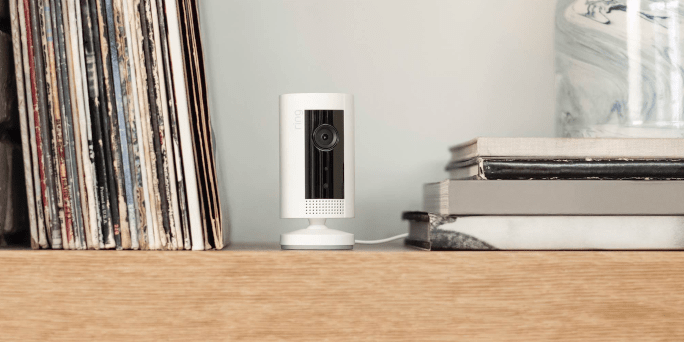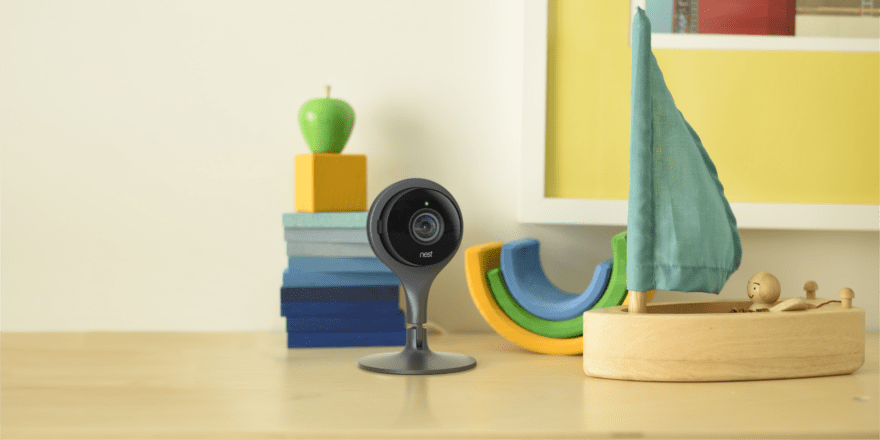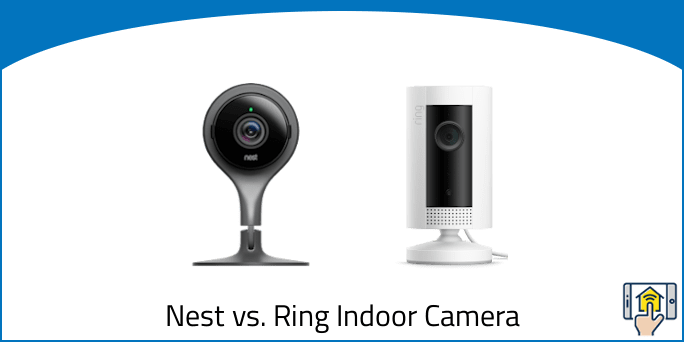Keep an eye on your home with an indoor camera!
Both Ring and Nest provide us with a couple of handy indoor cameras that are easy to set up and come with some pretty impressive features, such as motion detection, night vision, live-view on demand, and more!
Today we’ll be looking at the budget-friendly small scale Ring Indoor Camera and the flexible and widely recognized Nest Camera Indoor.
Below we go into detail on the similarities and differences of the Nest Indoor Camera vs. Ring Indoor Camera. Continue on for the full picture, or use our navigation bar to jump directly to the sections that interest you below.
Nest Indoor Camera vs. Ring Indoor Camera — Things in Common
Live-View on Demand – Make sure the chores are done or keep an eye on your pet via the live view on-demand feature! Both Nest Indoor Camera and Ring Indoor Camera come with a clear 1080p HD resolution that will allow you to see your home or office clearly from your iOS or Android smartphone.
Night View – And not only during the day! You can expect to view the live stream during the night time too, so you won’t miss your kids arriving late, or even have to worry about odd bumps throughout the night as you can check it out from the comfort of your bed using your smart device.
2-Way Talk – Say hi to your family, or even warn the dog off the couch with the two-way audio technology This allows you to seamlessly communicate with anyone via Nest or Ring app, while also allowing them to speak with you too! So now you can stay connected to your loved ones while you’re at work.
Power – Both Nest and Ring Indoor Cams connect to the power source with an Indoor power cable and adapter that is compatible with most standard sockets.
While this is a great option since your camera will have access to a constant source of power, however, for those of you who like the idea of a battery-operated smart camera, you should take a look at the all-new .
No products found.
Smart Home Integration – A feature that truly makes a smart camera smart, is the ability to integrate it into your smart home.
Both cameras can connect with IFTTT, Stringify and voice assistants such as Alexa, and Google.
IFTTT stands for “if this, then that” and this technology works by allowing you to create a series of automated commands between your smart devices. For example, you can set your smart light to glow orange when motion is detected, or log any activity into your Google Drive account. Either way, IFTTT is a great way to make your experience more efficient and a little fun too.
While using Alexa or Google voice assistants allow you to take advantage of hands-free control over your cameras.
You can use commands such as “Alexa, show me the living room” and the footage will be displayed on your smart device without having to lift a finger!
Yet it’s worth to keep in mind that while Ring is compatible with Google Assistant, it’s still quite limited in terms of voice command functions.
Plus, either camera integrates well with their own security systems like Ring Alarm and Nest Secure.
Nest Indoor Camera vs. Ring Indoor Camera — Differences

Difference #1: Field of View – Having a decent field of view is pretty important for your smart camera. As it determines how much of the room you can actually see, especially if you decide to use it as a baby monitor or as a way to keep an eye on your home while traveling.
Luckily, Ring Indoor Cam impresses us with it’s 140° diagonal,115° horizontal, and 60° vertical angle measurements vs. Nest’s 130° diagonal. Which is still pretty wide, yet Ring has the edge when it comes to coverage.
Difference #2: Motion Detection – Motion detection sensors alert us if something is wrong. For example whenever any activity is detected which may even be a potential intruder, or simply your kids running around.
Regardless of which, having a motion detection feature for your smart camera is pretty important.
While both Nest and Ring Indoor cameras have their own versions of this function, they do differ in a couple of ways.
For example, Ring comes with a customizable motion detection feature. This means that you can set specific areas for your Ring to pay special attention to which is similar to setting up custom motion zones, and that even includes person detection too! So you’ll get alerted when someone is in your home.
While Nest does have the basic motion detection function free of charge, if you want to take advantage of the person detection or even setting up custom motion zones, you’ll need to opt for the Nest Aware plan, however, the plans are affordable and include numerous benefits which we will take a look at now.
Difference #3: Subscription Plan & Storage – As neither camera comes with their own local storage apart from Nest’s limited 3-hour snapshot history, you’ll need to opt for a subscription plan in order to take advantage of the 24/7 recording feature and motion clip storage.
With Ring, you can choose between two plans, Basic and Plus.
With the Basic Plan, you have 60-day video history, snapshot capturing and the ability to share and review your videos as you please.
While with Ring Plus you have all the same perks, including 24/7 professional monitoring for Ring Alarm, 10% off select products at Ring.com and even Extended warranties for all devices.
The Basic Plan costs $3/month or $30/year, while Plus comes to $10/month or $100/year.
While with Nest Aware you have three subscription options available, 5-day, 10-day, or 30-day.
This refers to the number of days you’ll receive video history, 24/7 continuous recording, alerts, time-lapses, and activity zones. The price range starts from $5 per month for the 5-day plan, $10 for 10 days, and $30 for 30 days, with discount options for annual subscriptions.
Difference #4: Zoom – Another feature that can come in handy in terms of smart home security, is zoom. Zooming into a particular shot or video will allow you to see any suspicious clearly, and can even help you to identify a potential intruder.
Unfortunately, Ring doesn’t have this feature, while Nest impresses us with its 8x digital zoom.
Difference #5: Network –Both Nest Indoor Camera and Ring Indoor Camera connect to a 2.4GHZ WiFi network.
While Nest is also compatible with 5GHz as well, which can provide a much more durable and reliable connection, especially if you have quite a few smart home devices set up in your home.
Difference #6: Design – In terms of size, Ring Indoor Camera is a lot more compact with its measurements of 1.81″ x 1.81″ x 2.95″, compared to Nest’s bigger 4.5” x 2.8” build.
This makes Ring easy to place around your home, as it’s quite discreet and can blend in on a bookshelf or in the corner of your wall.
While Nest is stockier with a sleek round design and flexibility that can accent any room.
Nest Indoor Camera vs. Ring Indoor Camera — Comparison Chart
| Nest Indoor Camera | Ring Indoor Camera | |
|---|---|---|
| Resolution | 1080p HD | 1080p HD |
| FPS | 30 | – |
| Live-View on Demand | Yes | Yes |
| Field of View | 130° diagonal | 140° diagonal, 115° horizontal, 60° vertical |
| Zoom | 8x Digital Zoom | No |
| Power | AC | Indoor Power Adapter |
| Two-Way Talk | Yes | Yes |
| Motion Detection | Yes | Yes |
| Motion Zones | With Nest Aware | Yes |
| Person Detection | With Nest Aware | Yes |
| Sound Detection | Yes | No |
| Night Vision | Yes | Yes |
| Network | WiFi: 2.4GHz or 5GHz | WiFi 2.4GHz |
| Cloud Storage | 3-hour snapshot history or with Nest Aware |
Subscription Plan |
| Amazon Alexa | Yes | Yes |
| Google Assistant | Yes | Yes |
| IFTTT | Yes | Yes |
| Stringify | Yes | Yes |
| Dimensions | 4.5” x 2.8” | 1.81″ x 1.81″ x 2.95″ |
| Operating Temperature | 32° to 104°F | -5° to 113°F |
| Color | Black | White |
Nest Indoor Camera vs. Ring Indoor Camera — Accessories

Now that we have gone over Ring indoor camera vs. Nest indoor camera, let’s check out some of the accessories that you can include with your new smart camera.
For easy installation, why not take a look at Nest’s AC Outlet Mount or even the Twist Mount, for a better viewing angle.
If you’re worried about the quality of your network from Ring Indoor Camera, you can also include the Ring Chime Pro which not only acts as a WiFi Extender but can also be a chime for any outdoor cameras you may have.
If you really want to keep intruders at bay, take a look at Ring’s Solar Security Sign. It can easily be placed outside your home and will let people know that your home is secured with Ring.
Nest Indoor Camera vs. Ring Indoor Camera — Our Thoughts

Today we took a look at Ring vs. Nest indoor camera, and the unique benefits each camera brings.
Yet when it comes down to choosing the best one, we feel that that the budget-friendly Ring Indoor Camera is the superior choice.
While Nest Cam Indoor comes with some pretty great benefits such as it’s sound detection, and zoom, it still doesn’t beat the fact that Ring comes with more affordable subscription plans and doesn’t even require one in order to take advantage of its motion detection capabilities.
Last update on 2024-04-19 at 20:58 / Affiliate links / Images from Amazon Product Advertising API





